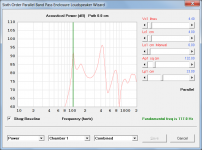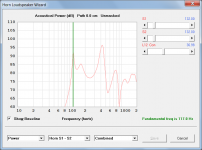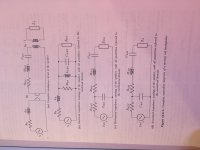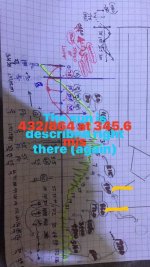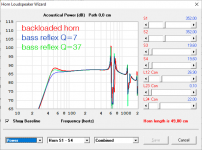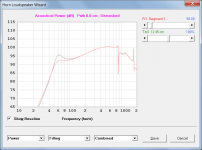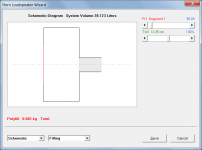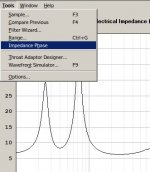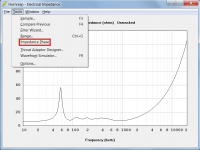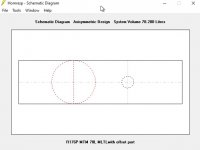hey fellow hornresp users!
Is there an compendium of the underlying equations that are used in hornresp?
Not speaking for David, but if you have ever modeled things in Akabak and HR and compared, it is reasonably safe to say that one can use Akabak documentation and the usual acoustics references for the things that both of them will model. If you have a specific question, that may aid responding. bosterst's OB stuff is in the thread, for example. The rest might have something to do with a madman and a 50 year labor of love to work on a program
Last edited:
There is a thread here wanting some help interpreting some results.
https://www.diyaudio.com/forums/sof...sp-vs-basta-winisd-vituixcad.html#post6857727
https://www.diyaudio.com/forums/sof...sp-vs-basta-winisd-vituixcad.html#post6857727
Sometimes I would like to better understand what hornresp is doing and how the results are achieved therefore the underlying equations would be very useful.
Hi Finn,
As explained in my earlier Post #10347, the Hornresp simulation model algorithms run into tens of thousands of lines of code. Unfortunately it is not just a simple matter of applying a few key equations:
https://www.diyaudio.com/forums/subwoofers/119854-hornresp-1035.html#post6037726
In essence, Hornresp analyses the complete electro-mechano-acoustical lumped-element equivalent circuit of a loudspeaker. The most complete reference book covering the theory behind Hornresp is "High Quality Horn Loudspeaker Systems" by Bjørn Kolbrek and Thomas Dunker.
Being able to see the hundreds of equations / formulas / algorithms used by Hornresp in a list, without fully understanding the theory underpinning them and the context in which they are being applied, would be of little value.
Kind regards,
David
Hi Finn,
As explained in my earlier Post #10347, the Hornresp simulation model algorithms run into tens of thousands of lines of code. Unfortunately it is not just a simple matter of applying a few key equations:
https://www.diyaudio.com/forums/subwoofers/119854-hornresp-1035.html#post6037726
In essence, Hornresp analyses the complete electro-mechano-acoustical lumped-element equivalent circuit of a loudspeaker. The most complete reference book covering the theory behind Hornresp is "High Quality Horn Loudspeaker Systems" by Bjørn Kolbrek and Thomas Dunker.
Being able to see the hundreds of equations / formulas / algorithms used by Hornresp in a list, without fully understanding the theory underpinning them and the context in which they are being applied, would be of little value.
Kind regards,
David
Hey David, I am sorry I completely forgot that I asked about this before! Fortunately I have that book now and will be able to further look into it.
Kind regards,
Finn
There is a thread here wanting some help interpreting some results.
https://www.diyaudio.com/forums/sof...sp-vs-basta-winisd-vituixcad.html#post6857727
I have no idea why the BP6P results produced by other programs should be different to those of Hornresp, using equivalent inputs.
I have validated the Hornresp BP6P results (Attachment 1) against those generated by modelling the design as a front loaded cylindrical horn having a throat chamber and vented rear chamber, and with an end correction added to the horn segment (Attachment 2).
Completely different models are used for the two cases, but the results are identical, ruling out the possibility of a bug in the Hornresp BP6P model. It would be interesting to construct the design and see what the actual measured results are.
In any event, unless I am missing something, the BP6P model does not seem to be a very good match to the Ripole enclosure shown in the thread.
Attachments
Hi Finn,
Not a problem, it's great to hear that you have a copy of the horn book - everything is in there, one way or another.
Be warned though, the theory can get pretty heavy in some places! It certainly helps to have a good grounding in physics and mathematics .
.
Kind regards,
David
Not a problem, it's great to hear that you have a copy of the horn book - everything is in there, one way or another.
Be warned though, the theory can get pretty heavy in some places! It certainly helps to have a good grounding in physics and mathematics
Kind regards,
David
The rest might have something to do with a madman and a 50 year labor of love to work on a program
When you put it like that, I must indeed be crazy - I need to get a life...
Hi finn,
Unfortunately it is not really possible to explain in a meaningful way how the Hornresp simulation models work without getting into highly technical detail. Chapters 16 and 19 of the horn book will give you a good insight into the theory and principles involved. In essence, Hornresp uses the equivalent circuit shown in Figure 16.6.1(a). Note that the electro-mechanical driver parameters Sd, Bl, Cms, Rms, Mmd, Le and Re (as shown on the Input Parameters window) are used in the model, rather than Thiele-Small parameters. Note also the comments in Section 16.5 relating to the complexity of the acoustical side of the model.
The Hornresp simulation model algorithms run into tens of thousands of lines of code - it is not just a simple matter of applying a few equations....
Kind regards,
David
Attachments
Something favors 12 parts of 360 as 30 cm and something shows up at 860 Hz over and over and over again there after at 860 intervals. It is peculiar it is quite specific but what’s in this window it is then lenient so to speak. It would be incredibly amazing and interesting if this is the kind of thing that was not at all the intentions of a horn response nor written into it or even obvious to David who made a program to design ducting systems for speakers not ‘Bodes’ law or astronomical references and Astrophtsucs a constants? But that’s what’s happening that’s in the results and so much more!
This may not be able to be described in typing but I’ll give it a shot because it’s far too interesting to just leave sitting there not shared). You can create the perfect model of the solar system and all of astrophysics and the numbers within as a subwoofer but by paying attention to the frequencies above that initially to create it).
If you split a circle into 270 and 90 (I am briefly describing a PH one sim ) .implement a driver entry at 30 from either(both) end of a system of 360 total you’re tapping into something at least as far as the acoustical shapes and length are concerned which also has a pattern which requires a CSA to achieve the 860 interval and it always will give you an 860 at 860 when you have that (?) abd absolutely how it is ‘wanted‘ by the math or the physics or whatever combines here ?? But whatever this is all based on it will give you 1720 and above infinitely with a lesser degree of detail placed on it due to the CSA s chosen. The same exact CSA throughout the S1-s4 And including the s6 through S9 only needs to be given a certain L4 five CSA and again a 30 cm length to which the above conditions occur. If you want to increase the CSA you can do so on the entire 90° side and the last 90 cm of the 270 side and of course then the L4 five segment again must subsequently have proportion to satisfy that narrow window of whatever is creating that repetitive 860hz . Which has a number and a frequency or a distance in time or legs from anything in physics is the diameter of the sun the seconds in a day and I can go on and on anon hear about how significant that is in any direction it’s the ratio of a right triangle placed onto a sphere amongst other things acoustically relevant it is the short leg of a right triangle if the distance of the earth from the sun is the long leg exactly and the hypotenuse of that is it 1728 which is twice the diameter of the sun
What ends up being is you’re playing with the parallax angle of the speed of light which is what the speed of light is an ark second of time on a pedal and swim or intestines at that angle which is technically 29.9792458 Degrees in this case being spread out in 12 parts as 30 cm each and using that 30 cm as an additional part to an exit and also an officer position for Driver entry.
Whatever all that stuff combine together creates the definition of it being unique would be the complete 860 interval showing up as -990 DB over and over and over again in the response when you double click on it to see the details when you look at other things in regards to all of this and what those numbers represent all over the place in the simulation you find absolutely positively on the money numbers that are relevant in astronomy and physics and in the cosmology of our own universe and then when you extrapolate that further by the pattern that those 86 zeros have within them that you’re fine as well at 48,96, 192.. That saddles the 860 offset to every other one to where they some of the 17 to 0 and repeat back-and-forth just like the pattern seen in the number 22÷7 and how it has a 0.142857 section that repeats and this when you look deeper and deeper into this with you establish that our response is indeed doing something that is completely appropriate according to what exists for real In both distance from the sun and seconds in time according to anything from the perspective of one day on earth that includes minutes at 1440 that are no longer 1440 when expressed as the distance to Saturn in million kilometers 14602zero Hertz expresses That as it should in the sidereal clock version of our solar system meaning you’re not basing it on the sun you’re basing it looking outside from the rest of the galaxy or the universe in you getting the correct perspective you’re getting the numbers as they are to the universe not to us. That’s the leap year functionWhat that means is I guess it’s hard to explain that’s the leap your function which in four years is 1461 days not degrees however that’s why it’s 365.25 which is actually a variety of numbers most of which have her around one that I had to make up to figure this all out which is just a little bit more than the Egyptian royal cubit is when I found that out then on response and everything about this amazing unity of numbers in real things including the shift and offset of time versus frequency versus however you wanna to is that only the simplest design one would think would be so incredibly complex as an eighth or a quarter pipe or whatever you wanna call it it’s simply a circle split into four quadrants all over again but within that and because of the driver position your drop the Fibonacci bomb and do that and the golden ratio starts at 15÷360 but we’re not talking about three and 60 were talking about 1440 which will be the frequency of the first harmonic in the short pipe. Or the 5/4 harmonic of whatever quarter weight fits into the adjacent pipe on these are two pipes that are using pipe harmonics or pipe physics in a way that soul is the universe at least in our solar system that we appear everything about that simulation in the details about it correct can’t find anything or the math derived from that pattern that is erroneous in anyway shape or form in fact the parts that do you look weird are the ones that have the best information in them because you have to then figure out what’s really going on as far as what is that representing if it if all of this is representative of anything it is a problem as quickly realized it is representing. I buy everything I mean literally everything that well that sounds ridiculous you do have to individually calculate everything based on the speed of light to see what everyone of those things is.
That all sounds weird but it’s 100% what’s happening and I am not even scratching the surface. You could simulate speakers in you can build stuff in response or you to figure out how the entire universe works by giving its information about circles? There is a peek or a valley at every single real number that is real in every way you’ll come to find out be at NASA or any website with legitimate details and data on our solar system and things in it that. However that includes a Compass or a Clock and seconds on it and the seconds on both which is 3600 another layer of 12×3×12×1212 times whatever you wanna call it plus that function of higher order math open above where you start to see the shift of the numbers that used to be other numbers in but still contain the other number But have grown with not just a logarithmic scale of tens and hundreds but a slight accruing thing which is exactly proportional to the breakdown of leap year to all of us on planet earth in reference to anything else in our solar system and you can see all that because her response produces exact same information.
That includes 25,920 which is the exact distance in spins of the earth from right now to watch me and people around me who are experiencing a certain season or whether will experience it again after it cycle with the tilt of the earth between this location and David my beans back-and-forth twice or the equivalent of 4×6480 hurts which is actually 6480 hz what is not very easy to describe is the fact that zero is not 00 is just another notch on the logarithmic scale of 1 to 10 or 1234 as they are 211 2233 and 44÷7 because this will all repeat so many times as you will see a very abbreviated version in Horn response and in the frequencies above the subwoofer pass but then the pattern that is produced goes on to tell even more information than you can digest in a month of pulling it apart and dissect it toss it as its all perfect And perfectly matches other things which witch verify multiple times and in multiple ways.
Where else does someone have the opportunity to encounter something like this is definitely not going to be The rabbit hole of Accomac that would chase someone into an infinite excessive version of too much information that it shouldn’t of been doing in the first place it would seem?
Orbital residence appears to be nothing but an offset pipe on an offset pipe in an offset system that it’s self is a larger pipe all of which demands that it has to be a rectangle to represent the volume of two spheres exactly inside all of that is in fact in that number along with the hypotenuse running between those two cubes in that mask that are formed which are hexagons as can be seen when drawing an isometric graph paper which contain individual triangles all of this breaks down right right there and the note and anti-node is in there at each level to become 7.5 in 360 at the very least? Because that is the waveform of the speed of light in the math around that if this is what’s going on and as far as I know I don’t know where I can speak for what you’ve got in your program here David but that’s where is all this heads otherwise and your program not only verifies but pretty much put a stamp on two of a lot of confusing ideas about a lot of things I just needed to mesh in a way that this presents and I’m I’m I mean frequencies and orbital residences Astro physics and acoustics are holding hands or kissing cousins hell they’re married Because that is the waveform of the speed of light in the math around that if this is what’s going on and as far as I know I don’t know where I can speak for what you’ve got in your program here David but that’s where is all this heads otherwise and your program not only verifies but pretty much put a stamp on two of a lot of confusing ideas about a lot of things I just needed to mesh in a way that this presents and I’m I’m I mean frequencies and orbital residences Astro physics and acoustics are holding hands or kissing cousins hell , they’re married it’s incredible. And to some extent you can play with this and extend it in 30 cm increments or 15 but you must maintain that pendulum swing throughout and at that interval can never break apart in a way that deviates from that however I am taking this down to 16 and 14 Hz with other drivers and maintain this type of arrangement based on 15 and 30 and then it adds up to more than 360 however that’s best as I can describe if it’s helpful to anyone who’s trying to figure out who the wizard is, and that somehow the Wizard in Oz our friend David is allowing us to look at so many things in order to understand this and that is quite amazing!!!
It’s gonna be done in a series pipe as well so it’s a matter of a variety of things and it all starts out in plain OD driver transmission line where 1.04761904 in 2.99792458 m meters reveals the effect of this as well because that’s the speed of light divided into It’s self has twice the 30° (As 0.5238095238 ) is 1.0476190476… , 60* as well. And te same function is occurring in those other things as it is quickly and easily shown in this. It’s all the speed of light not just in a speaker not just in the results of a certain shape in the speaker but in everything that involves real spins around some thing that is the physics of been defined by the number of pie and all of its details as well?
If anybody can make sense of this or dissect it further please please please do
Because the implications of what this starts to show is a chronological reference to things that can be used to define cycles in global warming Ice Age and known archaeological points to which are also found in the pattern that this defines and that kind of information is obviously incredibly important right this very moment in our own existence and more and more of that is in the details of the sim.
This may not be able to be described in typing but I’ll give it a shot because it’s far too interesting to just leave sitting there not shared). You can create the perfect model of the solar system and all of astrophysics and the numbers within as a subwoofer but by paying attention to the frequencies above that initially to create it).
If you split a circle into 270 and 90 (I am briefly describing a PH one sim ) .implement a driver entry at 30 from either(both) end of a system of 360 total you’re tapping into something at least as far as the acoustical shapes and length are concerned which also has a pattern which requires a CSA to achieve the 860 interval and it always will give you an 860 at 860 when you have that (?) abd absolutely how it is ‘wanted‘ by the math or the physics or whatever combines here ?? But whatever this is all based on it will give you 1720 and above infinitely with a lesser degree of detail placed on it due to the CSA s chosen. The same exact CSA throughout the S1-s4 And including the s6 through S9 only needs to be given a certain L4 five CSA and again a 30 cm length to which the above conditions occur. If you want to increase the CSA you can do so on the entire 90° side and the last 90 cm of the 270 side and of course then the L4 five segment again must subsequently have proportion to satisfy that narrow window of whatever is creating that repetitive 860hz . Which has a number and a frequency or a distance in time or legs from anything in physics is the diameter of the sun the seconds in a day and I can go on and on anon hear about how significant that is in any direction it’s the ratio of a right triangle placed onto a sphere amongst other things acoustically relevant it is the short leg of a right triangle if the distance of the earth from the sun is the long leg exactly and the hypotenuse of that is it 1728 which is twice the diameter of the sun
What ends up being is you’re playing with the parallax angle of the speed of light which is what the speed of light is an ark second of time on a pedal and swim or intestines at that angle which is technically 29.9792458 Degrees in this case being spread out in 12 parts as 30 cm each and using that 30 cm as an additional part to an exit and also an officer position for Driver entry.
Whatever all that stuff combine together creates the definition of it being unique would be the complete 860 interval showing up as -990 DB over and over and over again in the response when you double click on it to see the details when you look at other things in regards to all of this and what those numbers represent all over the place in the simulation you find absolutely positively on the money numbers that are relevant in astronomy and physics and in the cosmology of our own universe and then when you extrapolate that further by the pattern that those 86 zeros have within them that you’re fine as well at 48,96, 192.. That saddles the 860 offset to every other one to where they some of the 17 to 0 and repeat back-and-forth just like the pattern seen in the number 22÷7 and how it has a 0.142857 section that repeats and this when you look deeper and deeper into this with you establish that our response is indeed doing something that is completely appropriate according to what exists for real In both distance from the sun and seconds in time according to anything from the perspective of one day on earth that includes minutes at 1440 that are no longer 1440 when expressed as the distance to Saturn in million kilometers 14602zero Hertz expresses That as it should in the sidereal clock version of our solar system meaning you’re not basing it on the sun you’re basing it looking outside from the rest of the galaxy or the universe in you getting the correct perspective you’re getting the numbers as they are to the universe not to us. That’s the leap year functionWhat that means is I guess it’s hard to explain that’s the leap your function which in four years is 1461 days not degrees however that’s why it’s 365.25 which is actually a variety of numbers most of which have her around one that I had to make up to figure this all out which is just a little bit more than the Egyptian royal cubit is when I found that out then on response and everything about this amazing unity of numbers in real things including the shift and offset of time versus frequency versus however you wanna to is that only the simplest design one would think would be so incredibly complex as an eighth or a quarter pipe or whatever you wanna call it it’s simply a circle split into four quadrants all over again but within that and because of the driver position your drop the Fibonacci bomb and do that and the golden ratio starts at 15÷360 but we’re not talking about three and 60 were talking about 1440 which will be the frequency of the first harmonic in the short pipe. Or the 5/4 harmonic of whatever quarter weight fits into the adjacent pipe on these are two pipes that are using pipe harmonics or pipe physics in a way that soul is the universe at least in our solar system that we appear everything about that simulation in the details about it correct can’t find anything or the math derived from that pattern that is erroneous in anyway shape or form in fact the parts that do you look weird are the ones that have the best information in them because you have to then figure out what’s really going on as far as what is that representing if it if all of this is representative of anything it is a problem as quickly realized it is representing. I buy everything I mean literally everything that well that sounds ridiculous you do have to individually calculate everything based on the speed of light to see what everyone of those things is.
That all sounds weird but it’s 100% what’s happening and I am not even scratching the surface. You could simulate speakers in you can build stuff in response or you to figure out how the entire universe works by giving its information about circles? There is a peek or a valley at every single real number that is real in every way you’ll come to find out be at NASA or any website with legitimate details and data on our solar system and things in it that. However that includes a Compass or a Clock and seconds on it and the seconds on both which is 3600 another layer of 12×3×12×1212 times whatever you wanna call it plus that function of higher order math open above where you start to see the shift of the numbers that used to be other numbers in but still contain the other number But have grown with not just a logarithmic scale of tens and hundreds but a slight accruing thing which is exactly proportional to the breakdown of leap year to all of us on planet earth in reference to anything else in our solar system and you can see all that because her response produces exact same information.
That includes 25,920 which is the exact distance in spins of the earth from right now to watch me and people around me who are experiencing a certain season or whether will experience it again after it cycle with the tilt of the earth between this location and David my beans back-and-forth twice or the equivalent of 4×6480 hurts which is actually 6480 hz what is not very easy to describe is the fact that zero is not 00 is just another notch on the logarithmic scale of 1 to 10 or 1234 as they are 211 2233 and 44÷7 because this will all repeat so many times as you will see a very abbreviated version in Horn response and in the frequencies above the subwoofer pass but then the pattern that is produced goes on to tell even more information than you can digest in a month of pulling it apart and dissect it toss it as its all perfect And perfectly matches other things which witch verify multiple times and in multiple ways.
Where else does someone have the opportunity to encounter something like this is definitely not going to be The rabbit hole of Accomac that would chase someone into an infinite excessive version of too much information that it shouldn’t of been doing in the first place it would seem?
Orbital residence appears to be nothing but an offset pipe on an offset pipe in an offset system that it’s self is a larger pipe all of which demands that it has to be a rectangle to represent the volume of two spheres exactly inside all of that is in fact in that number along with the hypotenuse running between those two cubes in that mask that are formed which are hexagons as can be seen when drawing an isometric graph paper which contain individual triangles all of this breaks down right right there and the note and anti-node is in there at each level to become 7.5 in 360 at the very least? Because that is the waveform of the speed of light in the math around that if this is what’s going on and as far as I know I don’t know where I can speak for what you’ve got in your program here David but that’s where is all this heads otherwise and your program not only verifies but pretty much put a stamp on two of a lot of confusing ideas about a lot of things I just needed to mesh in a way that this presents and I’m I’m I mean frequencies and orbital residences Astro physics and acoustics are holding hands or kissing cousins hell they’re married Because that is the waveform of the speed of light in the math around that if this is what’s going on and as far as I know I don’t know where I can speak for what you’ve got in your program here David but that’s where is all this heads otherwise and your program not only verifies but pretty much put a stamp on two of a lot of confusing ideas about a lot of things I just needed to mesh in a way that this presents and I’m I’m I mean frequencies and orbital residences Astro physics and acoustics are holding hands or kissing cousins hell , they’re married it’s incredible. And to some extent you can play with this and extend it in 30 cm increments or 15 but you must maintain that pendulum swing throughout and at that interval can never break apart in a way that deviates from that however I am taking this down to 16 and 14 Hz with other drivers and maintain this type of arrangement based on 15 and 30 and then it adds up to more than 360 however that’s best as I can describe if it’s helpful to anyone who’s trying to figure out who the wizard is, and that somehow the Wizard in Oz our friend David is allowing us to look at so many things in order to understand this and that is quite amazing!!!
It’s gonna be done in a series pipe as well so it’s a matter of a variety of things and it all starts out in plain OD driver transmission line where 1.04761904 in 2.99792458 m meters reveals the effect of this as well because that’s the speed of light divided into It’s self has twice the 30° (As 0.5238095238 ) is 1.0476190476… , 60* as well. And te same function is occurring in those other things as it is quickly and easily shown in this. It’s all the speed of light not just in a speaker not just in the results of a certain shape in the speaker but in everything that involves real spins around some thing that is the physics of been defined by the number of pie and all of its details as well?
If anybody can make sense of this or dissect it further please please please do
Because the implications of what this starts to show is a chronological reference to things that can be used to define cycles in global warming Ice Age and known archaeological points to which are also found in the pattern that this defines and that kind of information is obviously incredibly important right this very moment in our own existence and more and more of that is in the details of the sim.
I find that in itself to be coolI have validated the Hornresp BP6P results (Attachment 1) against those generated by modelling the design as a front loaded cylindrical horn having a throat chamber and vented rear chamber, and with an end correction added to the horn segment (Attachment 2).
Completely different models are used for the two cases, but the results are identical,
hello all and thanks david for this absolutely great tool!
it's not only practically useful but immensely instructive.
this has probably been discussed already and i just did not find the right post:
when simulating a bass reflex box but using a horn model (or mass loaded TML) the losses of a standard bass reflex moldel (QL=7) are not considered.
so i suppose that any actually built loudspeaker following a lossless horn model will be affected by losses similar to the bass reflex model?
it's not only practically useful but immensely instructive.
this has probably been discussed already and i just did not find the right post:
when simulating a bass reflex box but using a horn model (or mass loaded TML) the losses of a standard bass reflex moldel (QL=7) are not considered.
so i suppose that any actually built loudspeaker following a lossless horn model will be affected by losses similar to the bass reflex model?
Attachments
Hi stv,
If the port tube is modelled using a horn segment (with an appropriate internal end correction added to the length), a small amount of absorbent filling material can be included to account for losses, as shown in the attachments.
It will certainly be affected - to what degree will depend upon the configuration of the system (number of bends in the acoustic path, etc), the material from which the loudspeaker is made, and the thickness of the material.
Kind regards,
David
when simulating a bass reflex box but using a horn model the losses of a standard bass reflex moldel (QL=7) are not considered.
If the port tube is modelled using a horn segment (with an appropriate internal end correction added to the length), a small amount of absorbent filling material can be included to account for losses, as shown in the attachments.
any actually built loudspeaker following a lossless horn model will be affected by losses similar to the bass reflex model?
It will certainly be affected - to what degree will depend upon the configuration of the system (number of bends in the acoustic path, etc), the material from which the loudspeaker is made, and the thickness of the material.
Kind regards,
David
Attachments
Shortcuts have also been added to menu commands that previously did not have them.
Sincere thanks for this, David!
FYI, impedance phase shortcut shown in menu is H but P works (fine as is, really).
Attachments
impedance phase shortcut shown in menu is H but P works
Hi grindstone,
Now that is really strange! The shortcut is shown correctly for me (at P not H).
Another one of life's little mysteries, it seems - it goes without saying that I can't do anything about it
Kind regards,
David
Attachments
I have validated the Hornresp BP6P results
See the post linked below for a further validation check:
https://www.diyaudio.com/forums/sof...sp-vs-basta-winisd-vituixcad.html#post6861624
If the port tube is modelled using a horn segment (with an appropriate internal end correction added to the length), a small amount of absorbent filling material can be included to account for losses, as shown in the attachments.
thank you very much, david!
offset port model problem
Hi David and folks,
I tried to model a MLTL with an offset port, and the schematic appears to show a port, but I don't think it's actually connected to Segment 3, and the power output I get looks more like a sealed box. So I need help

Hi David and folks,
I tried to model a MLTL with an offset port, and the schematic appears to show a port, but I don't think it's actually connected to Segment 3, and the power output I get looks more like a sealed box. So I need help
Attachments
- Home
- Loudspeakers
- Subwoofers
- Hornresp
